My
List |
Addition Date
|
Target
|
Mission
|
Instrument
|
Size
|

|
2017-01-24 |
NGC 7331
|
Chandra X-ray Observatory
|
Chandra X-ray Telescope
|
1800x1800x3 |
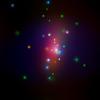
|
-
PIA21089:
-
Supernova SN 2014C (X-ray)
Full Resolution:
TIFF
(4.854 MB)
JPEG
(71.01 kB)
|

|
2017-01-24 |
NGC 7331
|
Chandra X-ray Observatory
SDSS
|
Chandra X-ray Telescope
|
864x864x3 |
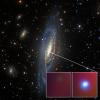
|
-
PIA21088:
-
Supernova SN 2014C (Optical and X-Ray)
Full Resolution:
TIFF
(1.854 MB)
JPEG
(82.92 kB)
|

|
2016-01-07 |
|
Chandra X-ray Observatory
Herschel Space Observatory
Spitzer Space Telescope
|
Chandra X-ray Telescope
IRAC
|
1719x1718x3 |
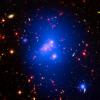
|
-
PIA20063:
-
Galaxy Cluster IDCS J1426
Full Resolution:
TIFF
(7.301 MB)
JPEG
(258.9 kB)
|

|
2014-10-08 |
|
NuSTAR
|
Chandra X-ray Telescope
Hubble Space Telescope
|
1200x675x3 |
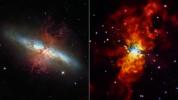
|
-
PIA18840:
-
Galaxy in Different Lights
Full Resolution:
TIFF
(2.431 MB)
JPEG
(58.14 kB)
|

|
2014-02-19 |
|
Chandra X-ray Observatory
NuSTAR
|
Chandra X-ray Telescope
NuSTAR
|
3000x2400x3 |
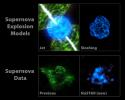
|
-
PIA17846:
-
NuSTAR Data Point to Sloshing Supernovas
Full Resolution:
TIFF
(21.61 MB)
JPEG
(378 kB)
|

|
2014-02-19 |
|
Chandra X-ray Observatory
NuSTAR
|
Chandra X-ray Telescope
NuSTAR
|
3000x2000x3 |
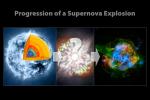
|
-
PIA17844:
-
Evolution of a Supernova
Full Resolution:
TIFF
(18.01 MB)
JPEG
(344.8 kB)
|

|
2014-02-19 |
|
Chandra X-ray Observatory
NuSTAR
|
Chandra X-ray Telescope
NuSTAR
|
2048x1024x3 |
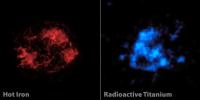
|
-
PIA17842:
-
The Case of Missing Iron in Cassiopeia A
Full Resolution:
TIFF
(6.294 MB)
JPEG
(87.83 kB)
|

|
2014-02-19 |
|
Chandra X-ray Observatory
NuSTAR
|
Chandra X-ray Telescope
NuSTAR
|
1024x1024x3 |
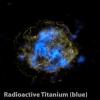
|
-
PIA17841:
-
Radioactive Core of a Dead Star
Full Resolution:
TIFF
(3.147 MB)
JPEG
(62.44 kB)
|

|
2014-02-19 |
|
Chandra X-ray Observatory
NuSTAR
|
Chandra X-ray Telescope
NuSTAR
|
3072x1024x3 |
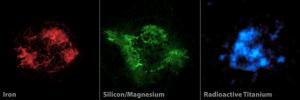
|
-
PIA17839:
-
Adding a New "Color" to Palate of Cassiopeia A Images
Full Resolution:
TIFF
(9.442 MB)
JPEG
(157.2 kB)
|

|
2014-02-19 |
|
Chandra X-ray Observatory
NuSTAR
|
Chandra X-ray Telescope
NuSTAR
|
3000x3000x3 |
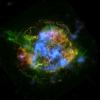
|
-
PIA17838:
-
Untangling the Remains of Cassiopeia A
Full Resolution:
TIFF
(27.01 MB)
JPEG
(350.8 kB)
|

|
2013-04-03 |
|
Chandra X-ray Observatory
Hubble Space Telescope
Spitzer Space Telescope
|
Chandra X-ray Telescope
IRAC
Visible-Light
|
3600x3600x3 |

|
-
PIA16884:
-
Taken Under the 'Wing' of the Small Magellanic Cloud
Full Resolution:
TIFF
(38.89 MB)
JPEG
(1.685 MB)
|

|
2011-11-16 |
|
Chandra X-ray Observatory
Spitzer Space Telescope
|
Chandra X-ray Telescope
IRAC
|
3600x3069x3 |
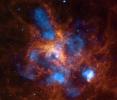
|
-
PIA15079:
-
30 Doradus: The Growing Tarantula Within
Full Resolution:
TIFF
(33.15 MB)
JPEG
(457 kB)
|

|
2011-10-24 |
|
Chandra X-ray Observatory
Spitzer Space Telescope
Wide-field Infrared Survey Explorer (WISE)
|
Chandra X-ray Telescope
IRAC
WISE Telescope
XMM-Newton X-ray
|
2811x2154x3 |
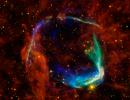
|
-
PIA14872:
-
All Eyes on Oldest Recorded Supernova
Full Resolution:
TIFF
(18.16 MB)
JPEG
(361.1 kB)
|

|
2011-09-28 |
NGC 281
|
Chandra X-ray Observatory
Spitzer Space Telescope
|
Chandra X-ray Telescope
IRAC
|
3600x2719x3 |
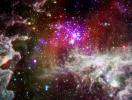
|
-
PIA14731:
-
The 'Pacman Nebula'
Full Resolution:
TIFF
(29.37 MB)
JPEG
(797.6 kB)
|

|
2010-03-29 |
|
Chandra X-ray Observatory
Spitzer Space Telescope
|
Chandra X-ray Telescope
IRAC
|
3600x3547x3 |
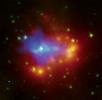
|
-
PIA12982:
-
Dusty Dead Star
Full Resolution:
TIFF
(38.31 MB)
JPEG
(303.8 kB)
|

|
2009-08-12 |
Cepheus B
|
Chandra X-ray Observatory
Spitzer Space Telescope
|
Chandra X-ray Telescope
IRAC
|
2749x3600x3 |

|
-
PIA12169:
-
Trigger-Happy Cloud
Full Resolution:
TIFF
(29.69 MB)
JPEG
(402.1 kB)
|

|
2009-02-10 |
Messier 101
|
Hubble Space Telescope
Spitzer Space Telescope
|
Chandra X-ray Telescope
IRAC
Visible Light
|
7200x7200x3 |

|
-
PIA11797:
-
NASA's Great Observatories Celebrate the International Year of Astronomy
Full Resolution:
TIFF
(155.5 MB)
JPEG
(6.529 MB)
|

|
2009-01-06 |
Cassiopeia A
|
Chandra X-ray Observatory
Spitzer Space Telescope
|
Chandra X-ray Telescope
IRAC
|
719x479x3 |
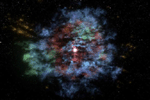
|
-
PIA11748:
-
Supernova Remnant in 3-D

Full Resolution:
TIFF
(1.035 MB)
JPEG
(36.78 kB)
|

|
2008-10-06 |
NGC 6193
|
Chandra X-ray Observatory
Spitzer Space Telescope
|
Chandra X-ray Telescope
IRAC
|
3300x3135x3 |
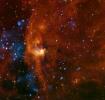
|
-
PIA11226:
-
RCW 108: Massive Young Stars Trigger Stellar Birth
Full Resolution:
TIFF
(31.04 MB)
JPEG
(524.6 kB)
|

|
2007-10-25 |
|
Chandra X-ray Observatory
|
Chandra X-ray Telescope
|
5100x2550x3 |
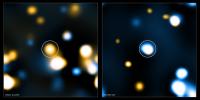
|
-
PIA10092:
-
Stacks of Light
Full Resolution:
TIFF
(39.02 MB)
JPEG
(385.4 kB)
|

|
2007-09-13 |
|
Spitzer Space Telescope
|
IRAC
Chandra X-ray Telescope
|
3300x3300x3 |
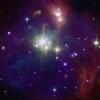
|
-
PIA09925:
-
Coronet: A Star-Formation Neighbor
Full Resolution:
TIFF
(32.67 MB)
JPEG
(407 kB)
|

|
2007-06-13 |
N132D
|
Spitzer Space Telescope
|
Chandra X-ray Telescope
Infrared Array Camera (IRAC)
Multiband Imaging Photometer (MIPS)
|
1806x1200x3 |
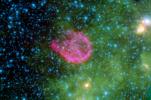
|
-
PIA09604:
-
A Supernova's Shockwaves
Full Resolution:
TIFF
(6.511 MB)
JPEG
(206.6 kB)
|

|
2006-04-24 |
M82 Galaxy
|
Hubble Space Telescope
Spitzer Space Telescope
|
Chandra X-ray Telescope
Infrared Array Camera (IRAC)
Visible Light
|
640x480x3 |

|
-
PIA08093:
-
Great Observatories Present Rainbow of a Galaxy

Full Resolution:
TIFF
(45.01 MB)
JPEG
(799.8 kB)
|

|
2006-01-11 |
Cartwheel Galaxy
|
Galaxy Evolution Explorer (GALEX)
Hubble Space Telescope
Spitzer Space Telescope
|
Chandra X-ray Telescope
GALEX Telescope
Infrared Array Camera (IRAC)
Visible Light
|
1500x1500x3 |
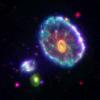
|
-
PIA03296:
-
A Stellar Ripple
Full Resolution:
TIFF
(6.762 MB)
JPEG
(201.2 kB)
|

|
2005-07-04 |
Tempel 1
|
Deep Impact
|
Chandra X-ray Telescope
|
458x425x3 |
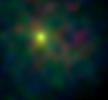
|
-
PIA02118:
-
X-ray Eyes on Tempel
Full Resolution:
TIFF
(584.9 kB)
JPEG
(7.752 kB)
|

|
2005-06-10 |
Cassiopeia A
|
Hubble Space Telescope
Spitzer Space Telescope
|
IRAC
Visible Light
Chandra X-ray Telescope
|
1835x1348x3 |
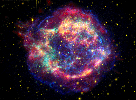
|
-
PIA03519:
-
Cassiopeia A: Death Becomes Her

Full Resolution:
TIFF
(7.432 MB)
JPEG
(263.6 kB)
|

|
2004-10-06 |
|
Chandra X-ray Observatory
|
Chandra X-ray Telescope
|
2400x2400x3 |
![The images indicate that the bubble of gas that makes up the supernova remnant appears different in various types of light. Chandra reveals the hottest gas [colored blue and colored green], which radiates in X-rays.](/thumb/PIA06908.jpg)
|
-
PIA06908:
-
Kepler's Supernova Remnant: A View from Chandra X-Ray Observatory
Full Resolution:
TIFF
(8.168 MB)
JPEG
(288.1 kB)
|

|
2004-10-06 |
|
Hubble Space Telescope
Spitzer Space Telescope
|
Chandra X-ray Telescope
Hubble Space Telescope
Spitzer Space Telescope
|
750x750x3 |
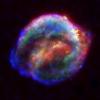
|
-
PIA06907:
-
Three Great Eyes on Kepler's Supernova
Remnant
Full Resolution:
TIFF
(1.453 MB)
JPEG
(33.78 kB)
|

 Planetary Data System
Planetary Data System







































![The images indicate that the bubble of gas that makes up the supernova remnant appears different in various types of light. Chandra reveals the hottest gas [colored blue and colored green], which radiates in X-rays.](/thumb/PIA06908.jpg)
